Attached files
| file | filename |
|---|---|
| EX-99.1 - EX-99.1 - SS&C Technologies Holdings Inc | ssnc-ex991_7.htm |
| 8-K - 8-K - SS&C Technologies Holdings Inc | ssnc-8k_20210728.htm |
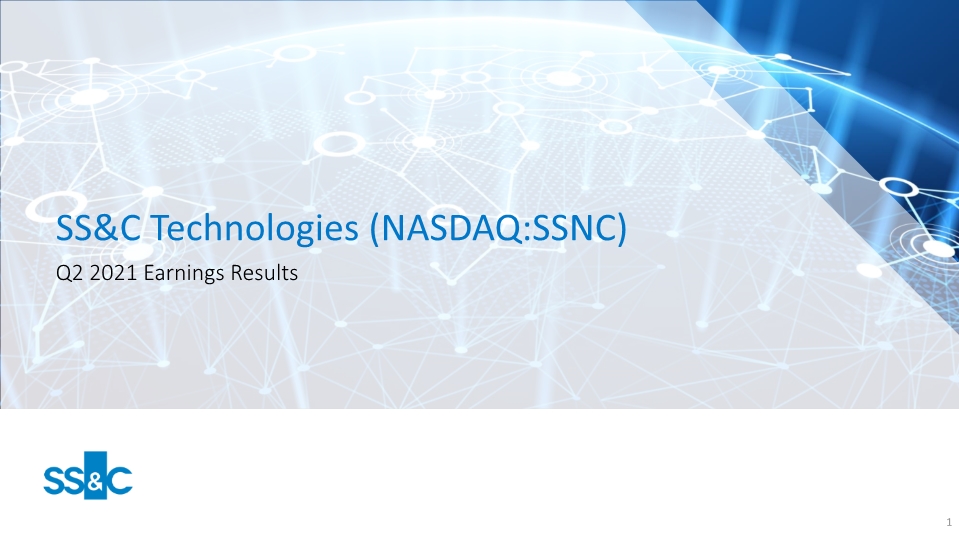
SS&C Technologies (NASDAQ:SSNC) Q2 2021 Earnings Results 1
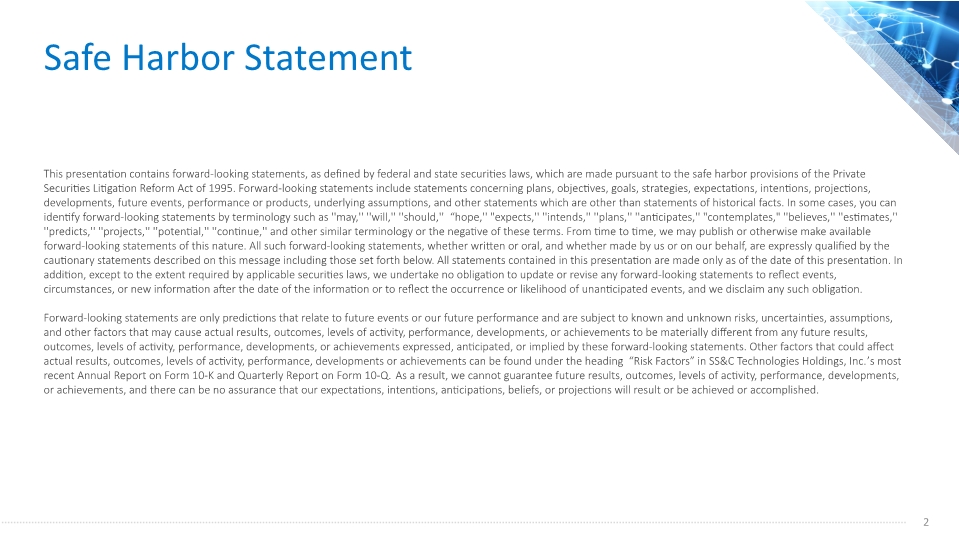
Safe Harbor Statement This presentation contains forward-looking statements, as defined by federal and state securities laws, which are made pursuant to the safe harbor provisions of the Private Securities Litigation Reform Act of 1995. Forward-looking statements include statements concerning plans, objectives, goals, strategies, expectations, intentions, projections, developments, future events, performance or products, underlying assumptions, and other statements which are other than statements of historical facts. In some cases, you can identify forward-looking statements by terminology such as ''may,'' ''will,'' ''should,'' “hope,'' "expects,'' ''intends,'' ''plans,'' ''anticipates,'' "contemplates," ''believes,'' ''estimates,'' ''predicts,'' ''projects,'' ''potential,'' ''continue,'' and other similar terminology or the negative of these terms. From time to time, we may publish or otherwise make available forward-looking statements of this nature. All such forward-looking statements, whether written or oral, and whether made by us or on our behalf, are expressly qualified by the cautionary statements described on this message including those set forth below. All statements contained in this presentation are made only as of the date of this presentation. In addition, except to the extent required by applicable securities laws, we undertake no obligation to update or revise any forward-looking statements to reflect events, circumstances, or new information after the date of the information or to reflect the occurrence or likelihood of unanticipated events, and we disclaim any such obligation. Forward-looking statements are only predictions that relate to future events or our future performance and are subject to known and unknown risks, uncertainties, assumptions, and other factors that may cause actual results, outcomes, levels of activity, performance, developments, or achievements to be materially different from any future results, outcomes, levels of activity, performance, developments, or achievements expressed, anticipated, or implied by these forward-looking statements. Other factors that could affect actual results, outcomes, levels of activity, performance, developments or achievements can be found under the heading “Risk Factors” in SS&C Technologies Holdings, Inc.’s most recent Annual Report on Form 10-K and Quarterly Report on Form 10-Q. As a result, we cannot guarantee future results, outcomes, levels of activity, performance, developments, or achievements, and there can be no assurance that our expectations, intentions, anticipations, beliefs, or projections will result or be achieved or accomplished. 2
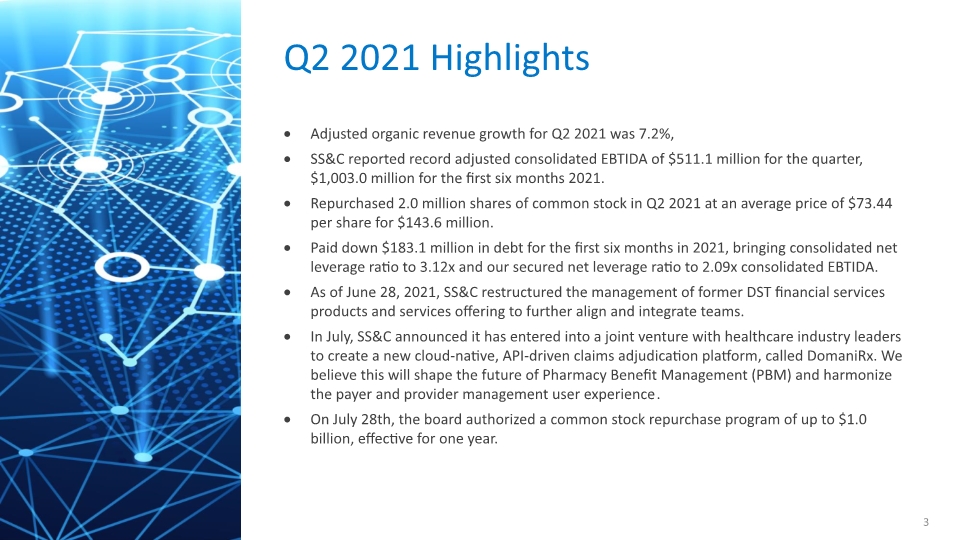
Adjusted organic revenue growth for Q2 2021 was 7.2%, SS&C reported record adjusted consolidated EBTIDA of $511.1 million for the quarter, $1,003.0 million for the first six months 2021. Repurchased 2.0 million shares of common stock in Q2 2021 at an average price of $73.44 per share for $143.6 million. Paid down $183.1 million in debt for the first six months in 2021, bringing consolidated net leverage ratio to 3.12x and our secured net leverage ratio to 2.09x consolidated EBTIDA. As of June 28, 2021, SS&C restructured the management of former DST financial services products and services offering to further align and integrate teams. In July, SS&C announced it has entered into a joint venture with healthcare industry leaders to create a new cloud-native, API-driven claims adjudication platform, called DomaniRx. We believe this will shape the future of Pharmacy Benefit Management (PBM) and harmonize the payer and provider management user experience. On July 28th, the board authorized a common stock repurchase program of up to $1.0 billion, effective for one year. 3 Q2 2021 Highlights
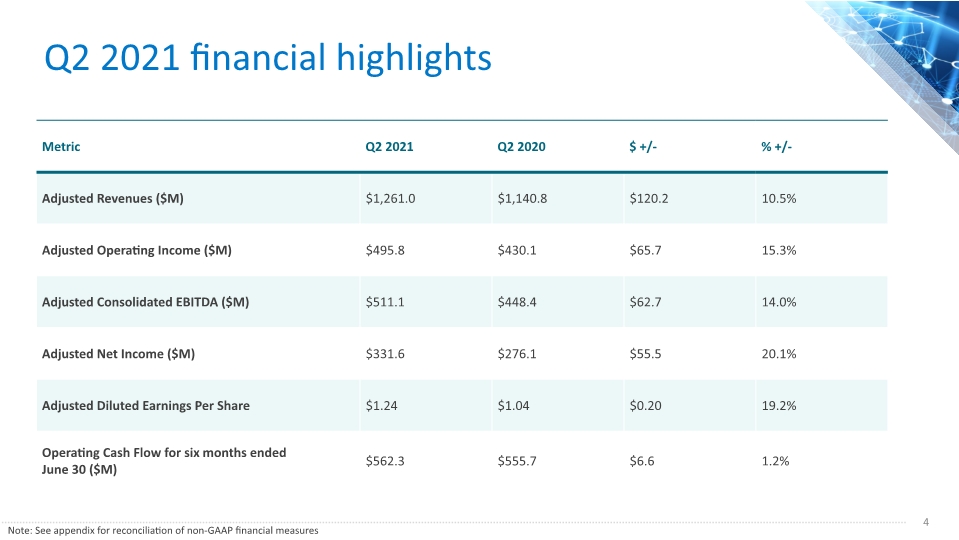
Q2 2021 financial highlights 4 Note: See appendix for reconciliation of non-GAAP financial measures
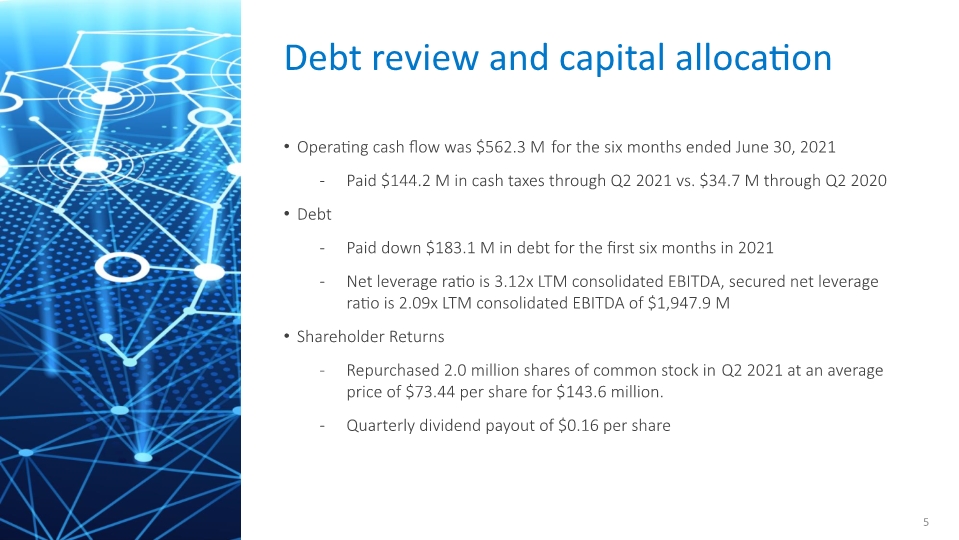
Operating cash flow was $562.3 M for the six months ended June 30, 2021 Paid $144.2 M in cash taxes through Q2 2021 vs. $34.7 M through Q2 2020 Debt Paid down $183.1 M in debt for the first six months in 2021 Net leverage ratio is 3.12x LTM consolidated EBITDA, secured net leverage ratio is 2.09x LTM consolidated EBITDA of $1,947.9 M Shareholder Returns Repurchased 2.0 million shares of common stock in Q2 2021 at an average price of $73.44 per share for $143.6 million. Quarterly dividend payout of $0.16 per share 5 Debt review and capital allocation
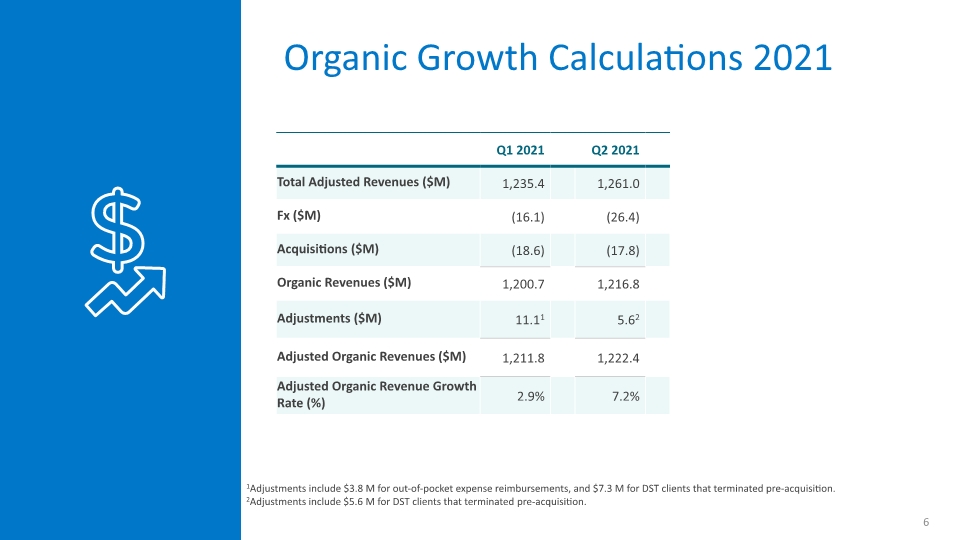
6 Organic Growth Calculations 2021 1Adjustments include $3.8 M for out-of-pocket expense reimbursements, and $7.3 M for DST clients that terminated pre-acquisition. 2Adjustments include $5.6 M for DST clients that terminated pre-acquisition.
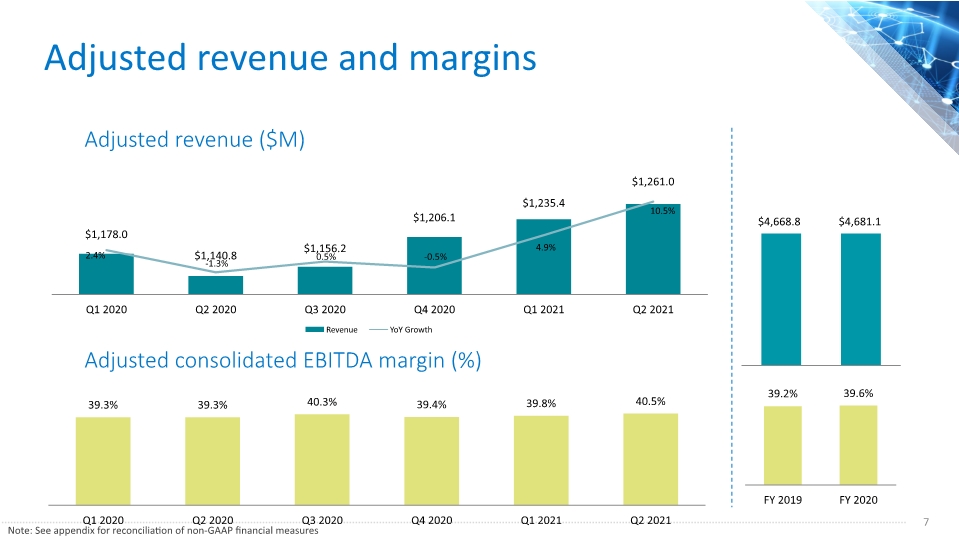
Adjusted revenue and margins 7 Adjusted revenue ($M) Adjusted consolidated EBITDA margin (%) Note: See appendix for reconciliation of non-GAAP financial measures
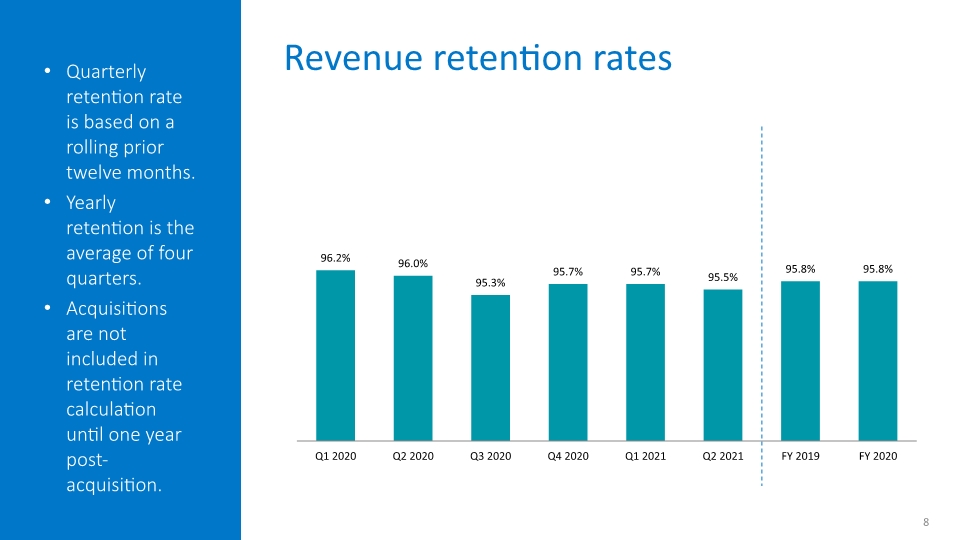
8 Quarterly retention rate is based on a rolling prior twelve months. Yearly retention is the average of four quarters. Acquisitions are not included in retention rate calculation until one year post-acquisition. Revenue retention rates
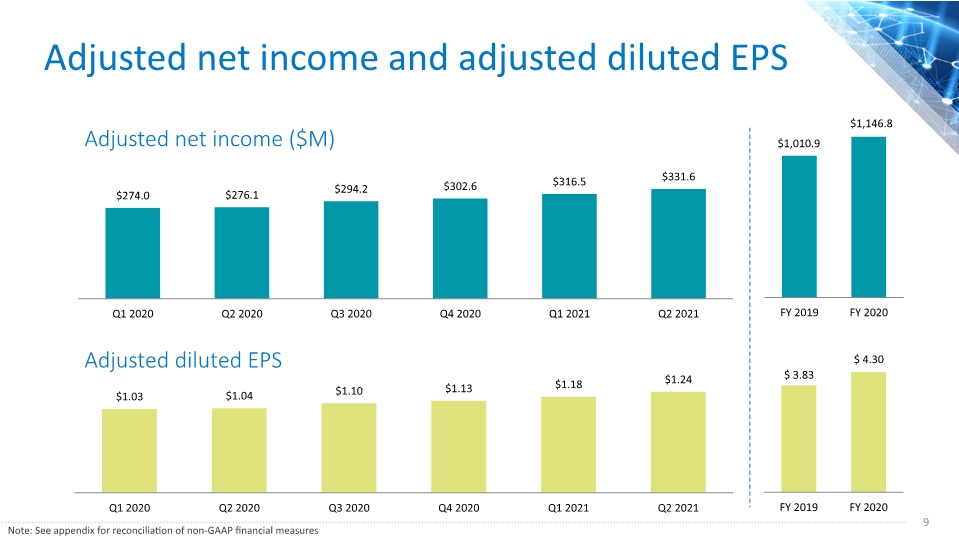
Adjusted net income and adjusted diluted EPS 9 Adjusted net income ($M) Adjusted diluted EPS Note: See appendix for reconciliation of non-GAAP financial measures
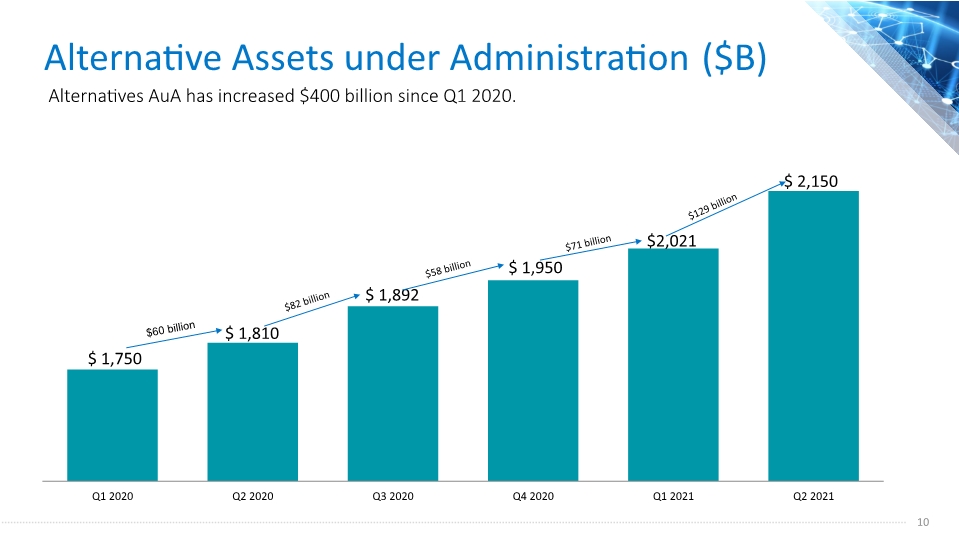
Alternative Assets under Administration ($B) 10 $82 billion $58 billion $71 billion $129 billion Alternatives AuA has increased $400 billion since Q1 2020.
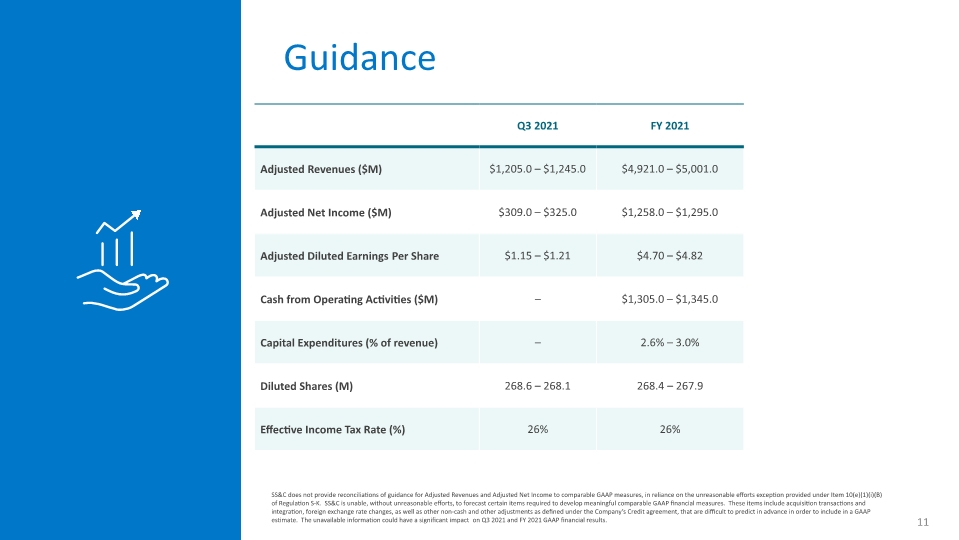
11 Guidance SS&C does not provide reconciliations of guidance for Adjusted Revenues and Adjusted Net Income to comparable GAAP measures, in reliance on the unreasonable efforts exception provided under Item 10(e)(1)(i)(B) of Regulation S-K. SS&C is unable, without unreasonable efforts, to forecast certain items required to develop meaningful comparable GAAP financial measures. These items include acquisition transactions and integration, foreign exchange rate changes, as well as other non-cash and other adjustments as defined under the Company’s Credit agreement, that are difficult to predict in advance in order to include in a GAAP estimate. The unavailable information could have a significant impact on Q3 2021 and FY 2021 GAAP financial results.
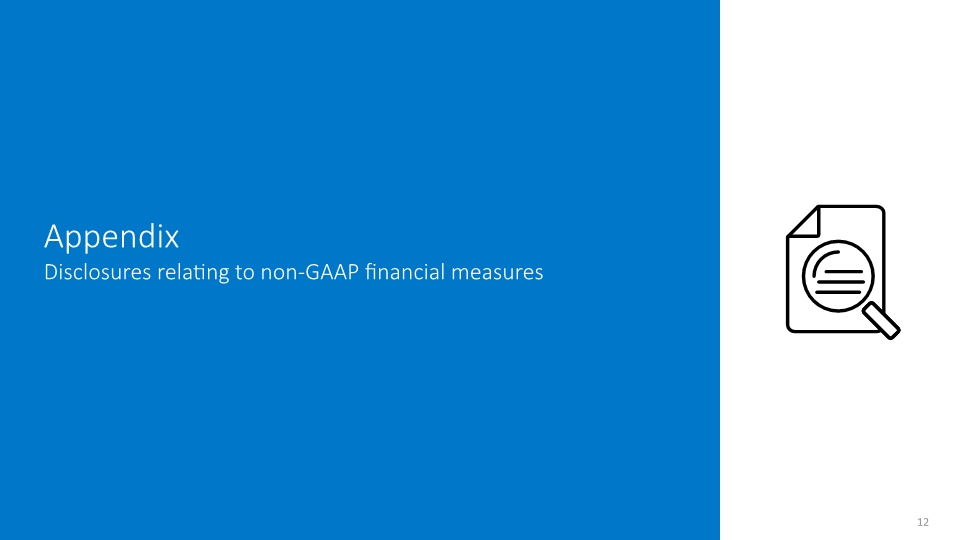
12 Appendix Disclosures relating to non-GAAP financial measures
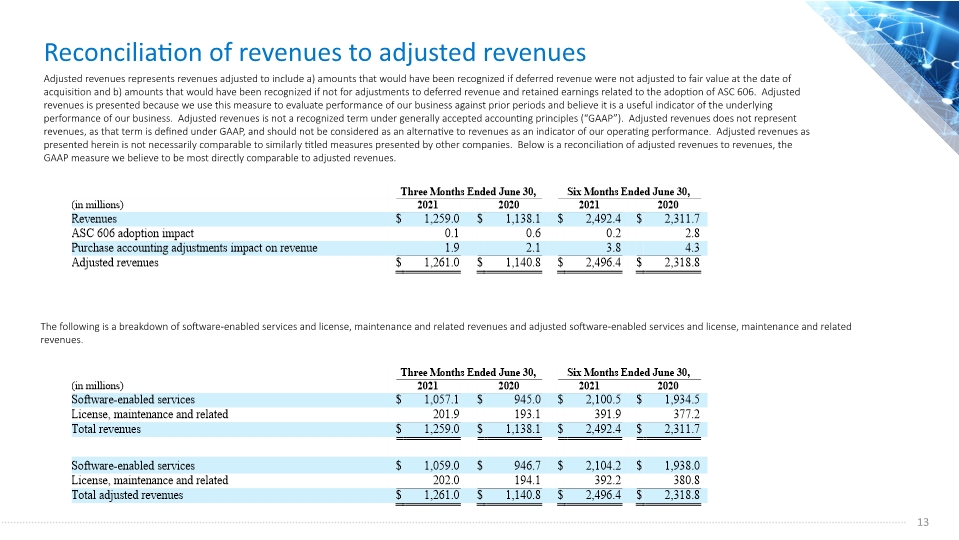
Reconciliation of revenues to adjusted revenues Adjusted revenues represents revenues adjusted to include a) amounts that would have been recognized if deferred revenue were not adjusted to fair value at the date of acquisition and b) amounts that would have been recognized if not for adjustments to deferred revenue and retained earnings related to the adoption of ASC 606. Adjusted revenues is presented because we use this measure to evaluate performance of our business against prior periods and believe it is a useful indicator of the underlying performance of our business. Adjusted revenues is not a recognized term under generally accepted accounting principles (“GAAP”). Adjusted revenues does not represent revenues, as that term is defined under GAAP, and should not be considered as an alternative to revenues as an indicator of our operating performance. Adjusted revenues as presented herein is not necessarily comparable to similarly titled measures presented by other companies. Below is a reconciliation of adjusted revenues to revenues, the GAAP measure we believe to be most directly comparable to adjusted revenues. 13 The following is a breakdown of software-enabled services and license, maintenance and related revenues and adjusted software-enabled services and license, maintenance and related revenues.
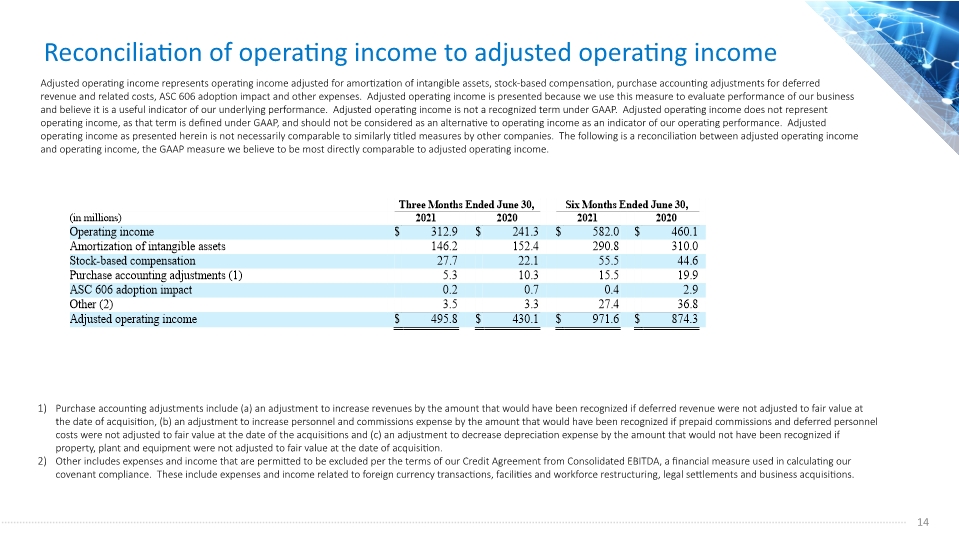
Reconciliation of operating income to adjusted operating income Adjusted operating income represents operating income adjusted for amortization of intangible assets, stock-based compensation, purchase accounting adjustments for deferred revenue and related costs, ASC 606 adoption impact and other expenses. Adjusted operating income is presented because we use this measure to evaluate performance of our business and believe it is a useful indicator of our underlying performance. Adjusted operating income is not a recognized term under GAAP. Adjusted operating income does not represent operating income, as that term is defined under GAAP, and should not be considered as an alternative to operating income as an indicator of our operating performance. Adjusted operating income as presented herein is not necessarily comparable to similarly titled measures by other companies. The following is a reconciliation between adjusted operating income and operating income, the GAAP measure we believe to be most directly comparable to adjusted operating income. 14 Purchase accounting adjustments include (a) an adjustment to increase revenues by the amount that would have been recognized if deferred revenue were not adjusted to fair value at the date of acquisition, (b) an adjustment to increase personnel and commissions expense by the amount that would have been recognized if prepaid commissions and deferred personnel costs were not adjusted to fair value at the date of the acquisitions and (c) an adjustment to decrease depreciation expense by the amount that would not have been recognized if property, plant and equipment were not adjusted to fair value at the date of acquisition. Other includes expenses and income that are permitted to be excluded per the terms of our Credit Agreement from Consolidated EBITDA, a financial measure used in calculating our covenant compliance. These include expenses and income related to foreign currency transactions, facilities and workforce restructuring, legal settlements and business acquisitions.
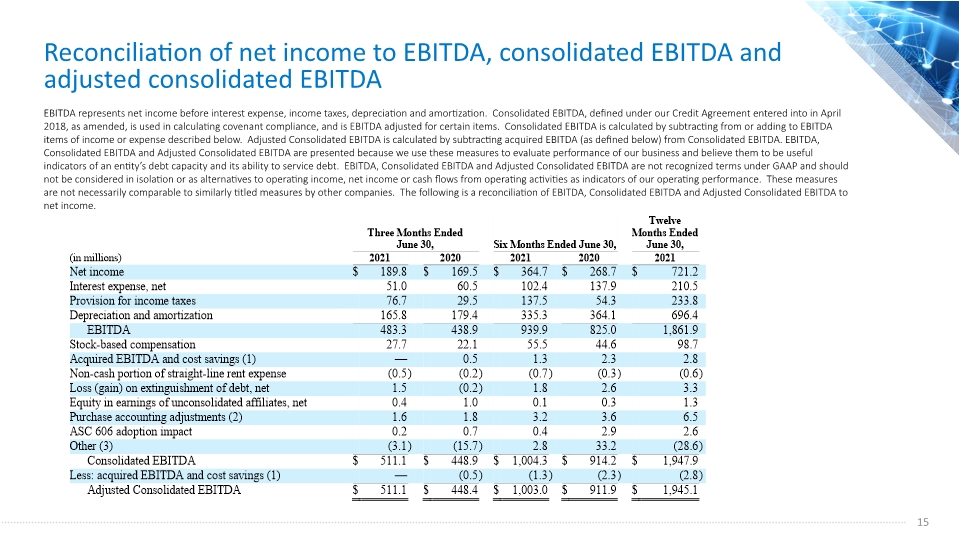
Reconciliation of net income to EBITDA, consolidated EBITDA and adjusted consolidated EBITDA EBITDA represents net income before interest expense, income taxes, depreciation and amortization. Consolidated EBITDA, defined under our Credit Agreement entered into in April 2018, as amended, is used in calculating covenant compliance, and is EBITDA adjusted for certain items. Consolidated EBITDA is calculated by subtracting from or adding to EBITDA items of income or expense described below. Adjusted Consolidated EBITDA is calculated by subtracting acquired EBITDA (as defined below) from Consolidated EBITDA. EBITDA, Consolidated EBITDA and Adjusted Consolidated EBITDA are presented because we use these measures to evaluate performance of our business and believe them to be useful indicators of an entity’s debt capacity and its ability to service debt. EBITDA, Consolidated EBITDA and Adjusted Consolidated EBITDA are not recognized terms under GAAP and should not be considered in isolation or as alternatives to operating income, net income or cash flows from operating activities as indicators of our operating performance. These measures are not necessarily comparable to similarly titled measures by other companies. The following is a reconciliation of EBITDA, Consolidated EBITDA and Adjusted Consolidated EBITDA to net income. 15
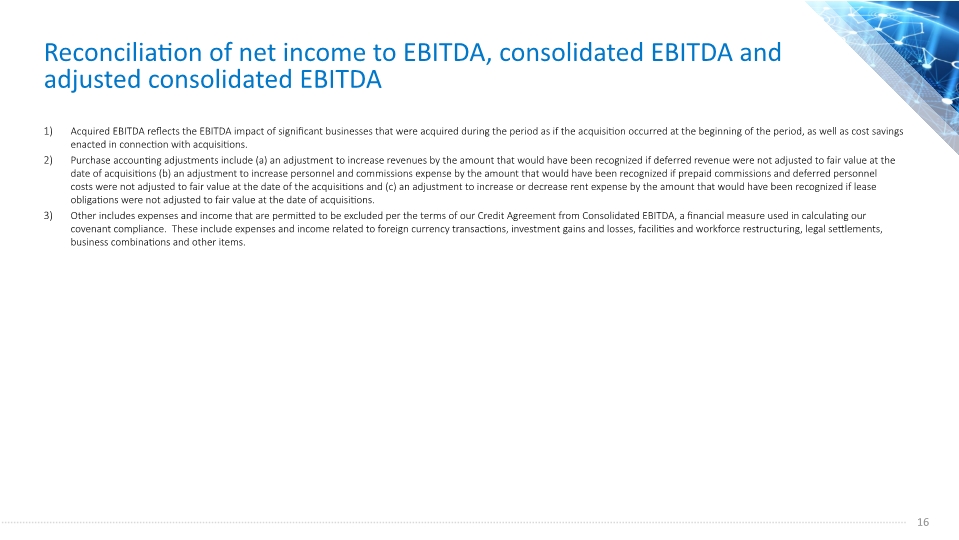
Reconciliation of net income to EBITDA, consolidated EBITDA and adjusted consolidated EBITDA Acquired EBITDA reflects the EBITDA impact of significant businesses that were acquired during the period as if the acquisition occurred at the beginning of the period, as well as cost savings enacted in connection with acquisitions. Purchase accounting adjustments include (a) an adjustment to increase revenues by the amount that would have been recognized if deferred revenue were not adjusted to fair value at the date of acquisitions (b) an adjustment to increase personnel and commissions expense by the amount that would have been recognized if prepaid commissions and deferred personnel costs were not adjusted to fair value at the date of the acquisitions and (c) an adjustment to increase or decrease rent expense by the amount that would have been recognized if lease obligations were not adjusted to fair value at the date of acquisitions. Other includes expenses and income that are permitted to be excluded per the terms of our Credit Agreement from Consolidated EBITDA, a financial measure used in calculating our covenant compliance. These include expenses and income related to foreign currency transactions, investment gains and losses, facilities and workforce restructuring, legal settlements, business combinations and other items. 16
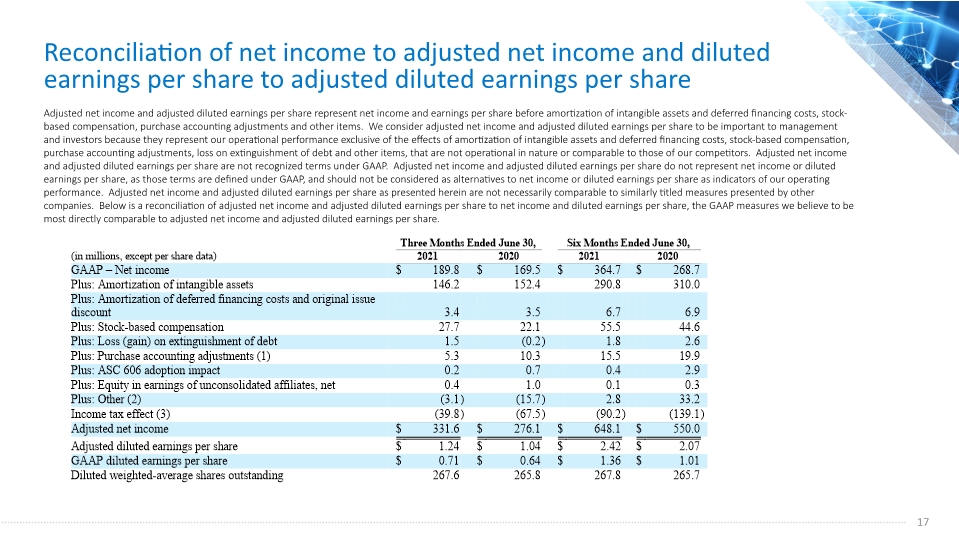
Reconciliation of net income to adjusted net income and diluted earnings per share to adjusted diluted earnings per share Adjusted net income and adjusted diluted earnings per share represent net income and earnings per share before amortization of intangible assets and deferred financing costs, stock-based compensation, purchase accounting adjustments and other items. We consider adjusted net income and adjusted diluted earnings per share to be important to management and investors because they represent our operational performance exclusive of the effects of amortization of intangible assets and deferred financing costs, stock-based compensation, purchase accounting adjustments, loss on extinguishment of debt and other items, that are not operational in nature or comparable to those of our competitors. Adjusted net income and adjusted diluted earnings per share are not recognized terms under GAAP. Adjusted net income and adjusted diluted earnings per share do not represent net income or diluted earnings per share, as those terms are defined under GAAP, and should not be considered as alternatives to net income or diluted earnings per share as indicators of our operating performance. Adjusted net income and adjusted diluted earnings per share as presented herein are not necessarily comparable to similarly titled measures presented by other companies. Below is a reconciliation of adjusted net income and adjusted diluted earnings per share to net income and diluted earnings per share, the GAAP measures we believe to be most directly comparable to adjusted net income and adjusted diluted earnings per share. 17
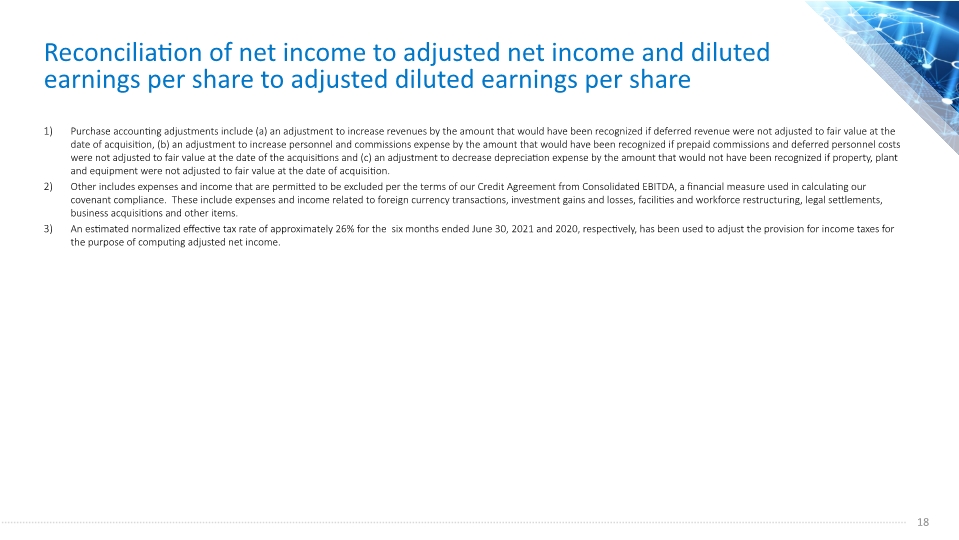
Reconciliation of net income to adjusted net income and diluted earnings per share to adjusted diluted earnings per share Purchase accounting adjustments include (a) an adjustment to increase revenues by the amount that would have been recognized if deferred revenue were not adjusted to fair value at the date of acquisition, (b) an adjustment to increase personnel and commissions expense by the amount that would have been recognized if prepaid commissions and deferred personnel costs were not adjusted to fair value at the date of the acquisitions and (c) an adjustment to decrease depreciation expense by the amount that would not have been recognized if property, plant and equipment were not adjusted to fair value at the date of acquisition. Other includes expenses and income that are permitted to be excluded per the terms of our Credit Agreement from Consolidated EBITDA, a financial measure used in calculating our covenant compliance. These include expenses and income related to foreign currency transactions, investment gains and losses, facilities and workforce restructuring, legal settlements, business acquisitions and other items. An estimated normalized effective tax rate of approximately 26% for the six months ended June 30, 2021 and 2020, respectively, has been used to adjust the provision for income taxes for the purpose of computing adjusted net income. 18
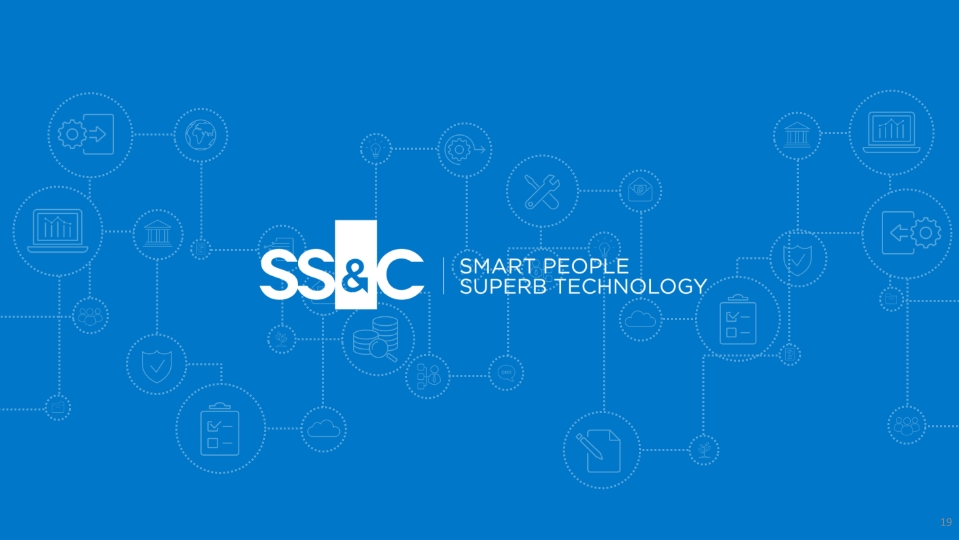
19
